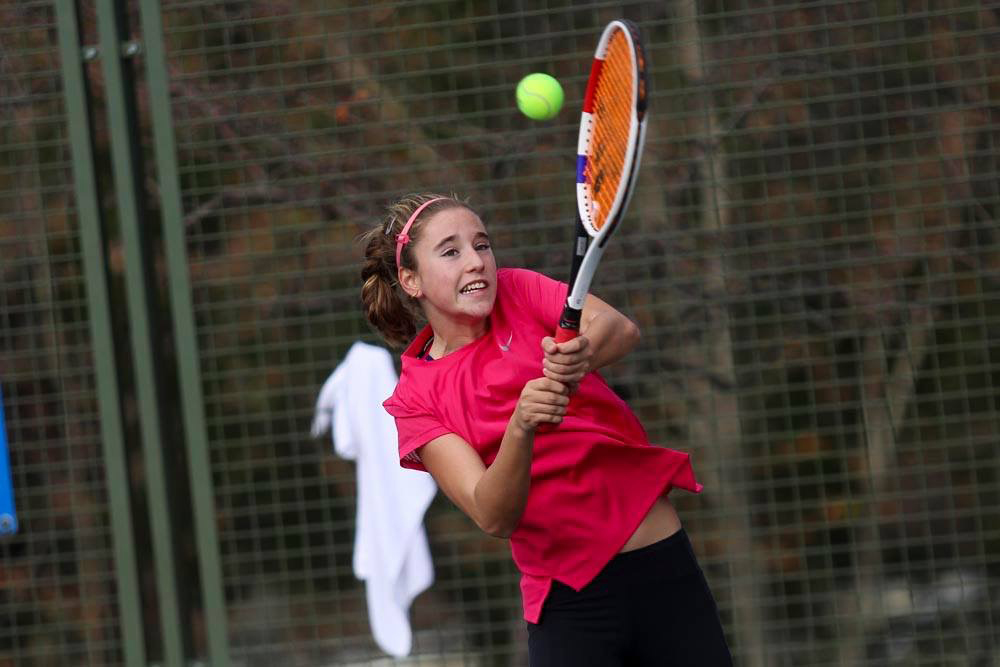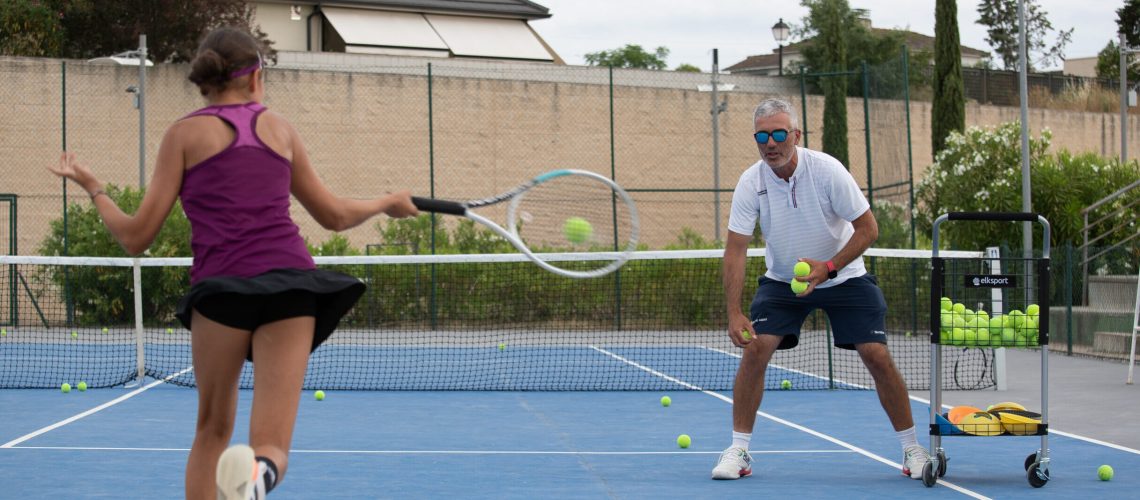Wind is an almost permanent aspect on a tennis court. Most of the year we play outdoors, especially in countries like Spain, and that forces us to take into account the weather aspects, which affect the game to a greater or lesser degree. How to play with the wind is one of the issues that we must address with special attention, since it can serve as a powerful ally for the game. There are multiple details to take into account and we will try to analyze them individually, but we will start with the most important: the Mental Aspect.
How to mentally face the wind
Turn the wind into your ally
Our predisposition to accept the wind when entering a tennis court is of great importance. We must be clear that there are events that do not depend on us, which we cannot change, and we have to work with (NOT AGAINST) them. This same issue is the Achilles’ heel of many players who enter the court and start a battle from which no winners can emerge, a battle against the wind. But turning the idea around, the fact that this happens may be a weapon to use against our opponents. If you accept the wind and make it your ally, you will have a great advantage over the player who does not. You can use the wind to win the game while your opponent is busy and distracted by the wind, without realizing what is happening on the court.
So on the windy day, accept the fact that it’s not in your hands to change it and the adaptation work begins. Be flexible and emotionally open to accept the challenge and, instead of perceiving it as an obstacle, try to see it as a springboard to become a more effective and dangerous player.
Accept that your shots are not going to be smooth
With the wind, your fluid game (if it was before) will no longer be the same. It is similar to traveling by plane: there are areas of smooth flight and others of turbulence. The player who suits best will have the most advantage. And here is one of the most important mental aspects, what I call “the Wax Statue”. I have commented sometime, I think in the article “Letters to a Player“, that you should never have a predetermined image of your level of play; You must accept yourself with all the diversity that this implies: from the worst to the best of your level, in all that range of possibilities there is, it is you. Be flexible in seeing yourself. Do not build fixed ideas of your shots. As a child I was taught to see my level through my worst day; It is hard to accept it mentally, but it is very effective if you succeed, since everything that can come supposes a sum and that includes that you will always see yourself constructively.
Thus, in relation to the wind, accept the fact that the quality of the shots (yours and also those of your opponent) will decrease. Do not try to find that precision you have on windless days. Don’t try to find the player you imagine you to be. Adapt and accept the ugly face of your game and work with it. Otherwise, when you don’t see yourself as you imagine, you are going to reject yourself, and that supposes what we call “throwing a game”. So get to work, take on the dirty work and start building with what you have in your hands. Remember that even the most beautiful buildings are built in mud.
Different types of wind
Front wind
We will concisely describe the types of wind you can find on the tennis court. Those that suppose an easier adaptation are the frontal winds that blow continuously. In this case, from the beginning, you can see which side the viewer blows at, at what speed and thus adapt your shots.
Crosswind
Then there is the diagonal or lateral wind. This type of wind involves a double adaptation: on the baseline (check where you are for and where you are against the wind) and lateral (see where the ball is easier to open and go out and where the wind forces the ball back to the court).
Gusty wind, gusts, eddies …
The most complicated are gusty winds, which blow with gusts and eddies. In these cases, you must be very attentive, since its speed changes constantly and that will require you to seek adaptation in each shot. In addition to specifying the speed and placement of the shot, you will have to play with greater mobility, which should already be high in any type of wind.
Wind speeds
The speeds with which the wind usually blows will not be defined by km/hour, but through concepts directly linked to our performance on the court:
- The first would be that wind that can affect the trajectory of the ball: this can happen from a light breeze to, sometimes, with an imperceptible wind but capable of changing the direction of our shots.
- The second, the wind that affects our stroke (swing): we notice its resistance on the racket motion that leads to greater tension in our stroke and thus uncoordinates it.
- And the third, the very strong wind that already affects our mobility: we notice its presence in our movements on the court.
In all these cases, we have to manage the adaptation of each of these aspects, being aware of the part of our work that may be under the influence of the wind.
Tips on how to play in the wind
How to find out which way the wind blows
Very easy. Before getting on the court, especially if you are in a tournament, look for a flag near it (almost always you can find one in tournaments). Anything that can flap in the wind could do; with it you can see in which direction the wind blows. If you do not see flags, you can see umbrellas, nets, vegetation or the typical trick of getting your finger wet and raising it in the air as it was done in the past. In the case of playing on a clay court, you can take a handful of clay and drop it; This way you will see in which direction the dust spreads and with it where the wind blows.
Which side to choose to start the match?
In the draw, in case there is wind, it is preferable to choose to start on the side where you have the wind against you; The reason is the tension that you can have at the beginning of the match, which causes rigidity and shortening of gestures. Being at the start of the match against the wind, you can better release your shots and discharge that tension without having much danger of the balls going out. We must also remember that in the first strokes of the warm-up we must focus on lengthening the gestures and following through; this will be easier when the wind helps keep the ball within the baseline.
The opposite happens if we are in favor of the wind: if we are emotionally tense, we will shorten the gestures in the first shots of the match and if we see that the balls go out, there is a danger that we will continue to do so. That can lead to insecurity and a somewhat off-beat start; therefore, choosing the side against the wind helps us let go at the beginning of the game and gain confidence, entering the match with greater ease.
How to play against the wind
Positioning and distances
If you are playing against the wind, one of the things you should look at is the distances. With the wind in his back, your opponent’s ball will advance more and will eat you space, so you must keep more distance with the ball to get behind. Also, you will need more body support in your shots to move the ball against the wind, which requires taking more distance in relation to the contact point. Therefore, you can position yourself slightly behind the baseline than you usually are and keep in mind that when a ball is thrown at you with topspin, it will bounce with greater big due to the force of the accompanying wind.
Play more crosscourt with the headwind
One of the things to keep in mind when playing against the wind is the shots you choose: if you play flat, we have said that you must put a lot of weight on the ball, accompanying with your body. Still, straight down the line shots will do less damage to your opponent as the wind will slow down their power. In addition, you will spend more energy trying to generate force against the wind. Because of this, most shots to deal damage must be played crosscourt. The wind, when opening the court with a crosscourt shot, will make the ball stop and take it further out of the court; It will also help you generate more angle each time the ball advances. For this reason, play with more crosscourt with the headwind: this way you will get more advantage working with the wind as an ally.
The service return with the wind against you
In the return, remember that you are against the wind: stay further away, taking more distance; Go back if you are bothered by the power of the serve with the wind in his/her favor. This gives you a little more time to react and return the service more safely. Remember that both the flat and the kick serve will advance loaded with extra power.
How to play downwind
Positioning and distances
In case of playing downwind, try to fill the space in front of you, get closer to the ball: the wind will stop the ball and that can give you many opportunities to advance to the pressure or attack zone. Do not wait behind, do not let the ball drop, look for it forward and shorten the distances: play inside the court, play live balls.
Play deep or down the line and with spins
In favor of the wind, you should take advantage of the depth, since the wind will help you generate more power in the ball. Play deep or down the line downwind. If you try to open the court too wide with crosscourt, the wind will bring the ball to the baseline and you will lose the effectiveness of the crosscourt shot. Therefore, look for more depth with spin and take advantage to carry out down the line shots when you see a gap on the court.
In addition, to maintain control you will need to play with greater spins: this way you can keep the balls inside the court. Avoid hitting flat shots as the wind will cause the ball to fly out of control. Load your shots with topspin. The balls will bounce with a lot of energy on the baseline and will force the opponent to go back to the defense zone: it will be a good moment to seek to advance towards the net, at least, to close the spaces to your opponent.
The service return in favor of the wind
Get closer inside! Calculate the power of the serve, but be careful: you will have good opportunities to return the serve inside the baseline. The ball will lose strength as it moves towards you; and if the opponent sees you get inside the court several times, in important moments he will get even more stiff and will leave the ball even shorter; so go in, put more pressure and take advantage of the wind.
How to serve with the wind
Downwind
The general concept is as follows: the higher you toss the ball and the longer the ball is falling until you hit it, the more the wind will move it and the more it will cost you to find the clean contact point; so you have to toss the ball very close to where you are going to hit it. That would be the basic rule. For this, it is advantageous to serve more slice, since in this type of serve you do not drop the ball much; You can also hit serves by shortening as far as possible the height at which you throw the ball. And be careful with topspin, since in this case we do drop the ball more to generate more kick and that with the presence of wind can cause problems.
It is advisable to look for serves with spin instead of serving flat. The ball will move a lot when you throw it out and this will cause you to lose precision. The high power serve percentage will go down. So try to vary more with the slice serves to maintain the percentages. In case you feel comfortable and know how to play with the wind, you can look for one or another serve with power, but without losing sight of the effectiveness that you can get.
Otherwise, when you’re upwind, try to take advantage of the extra power on the first serves. It is important to maximize the contact point to have a greater angle of entry of the ball and thus counteract its greater advance with the wind. Serve with different spins, since the ball will get crazy twice as much with the wind. Look for a kick (carefully), which will make the ball jump and advance further and do not be afraid to go up to the net or, at least, pay attention to the returns that remain in the half court; And just like baseline shots, don’t look for too many open angles. Go for the depth, the body and the serves to the T.
Against the wind
Against the wind you must be careful with the serve, since the receiver will eat up your space. The serve to avoid is the kick with which you are looking for the depth in the service box to take your opponent back; This type of serve will be completely stopped at shoulder height so that the receiver may attack you. Look for more slice, flat, low and fast serves that cut the wind. Play with body serve with different spins and, just as at the baseline, go for open angles to get the opponent outside of the court.
Another thing you have to take into account is adjusting how you throw the ball in the wind: whether you are for or against it, you must throw it to compensate for the force of the wind and leave it in the place where you want it to get a contact.
How to hit an overhead on a windy day
Even more than in the serve, in the overhead you must be careful with the high balloons: in case you can drop the ball, you should. And if this is not the case and you have to hit the ball in flight, then work until the last moment with your feet to adjust yourself in the best possible way to get under the ball, keeping your eyes on it until the end.
Drop shots with the wind
Do the drop shot against the wind, do not do it in favor. With the backwind the ball will advance towards the opponent and it will be an easy shot for him. Make your drops when you are against the wind; Calculate the force with which the air blows and do it. The ball will stay dead, it will slow down, and if you hit it with some slice, it will even go back to the net. So do not hesitate to use this weapon when you have the front wind and see how it works for yourself.
How to lob with the wind
In general, it is not advisable to throw a high ball that hangs in the air, since you are at the mercy of the wind and its whims. The ball must be loaded with spin to cut the air and give it direction. So if you throw a lob, do it with intention and charge it with effects. Remember that against the wind the ball is going to stop, so you need to transmit more power to move it forward. With the backwind, you need generate more spin so that it does not go long. And also keep in mind the following: the wind can be different at a certain height: when you throw a high ball, at 5-6 meters high the wind can change and move the ball; so watch out when you choose to lob on a windy day.
Cross winds – center
When playing in crosswinds, the balls can move laterally. To better calculate how the wind blows, play with more margin at first. You can even aim and play in the center and thus know its strength and trajectory. Once you have it under control, you can now open more angle, taking into account the side of the court where you will have more risk to adjust the shot.
Move your feet
One of the keys to knowing how to play in the wind is mobility. The ball may change trajectory or direction and you must be careful to adjust. You will need more steps and more frequency to get a good distance from the contact point. You should also work with your feet until the last moment to prevent the ball from moving at the last moment and ending up hitting from an uncomfortable position.
Watch the ball
In addition to mobility, it will help a lot if you take a good look at the ball. Check the article “Three Points of Vision“. Connect and coordinate with the ball. Fix the contact point well and keep the focus on the ball to perceive changes in its trajectory in time. Those milli-seconds that you can get from being attentive with the ball can give you quite an advantage on a windy day.
Don’t be ashamed of making a fool of yourself
And finally, to finish up, DO NOT BE ASHAMED TO MAKE THE RIDICLE. In the wind you can sometimes seem like a beginner hunting butterflies. Nothing happens. It’s part of the game. Take it on and that will make you stronger. Don’t be ashamed of looking like a beginner or finding yourself in a funny situation. Be clear about one thing: you want to win the point and you want to win the game. That is your goal. And the wind will play in your favor if you leave it, if you receive it as your ally.










